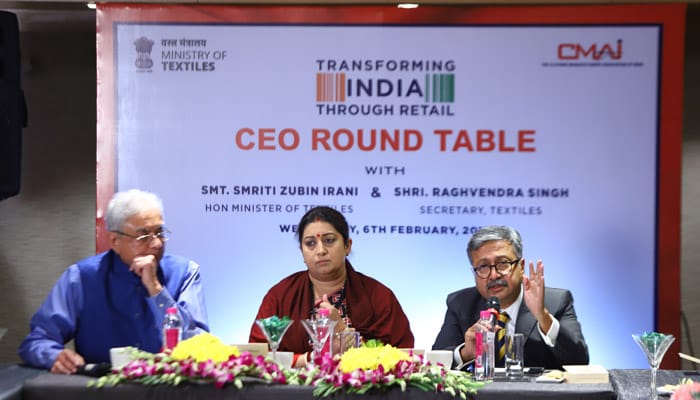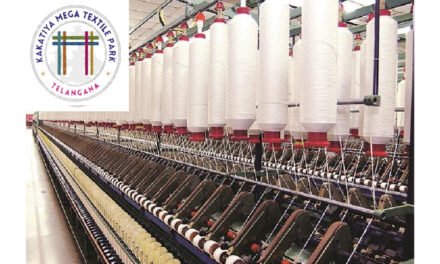Hon’ble Minister of Textiles, Smriti Zubin Irani launched the Indian Size Project in collaboration with CMAI on 6th February at a function held in Mumbai. Also present at the event were Raghvendra Singh, Secretary Textiles, and Ajit Chawan, Secretary Textiles Committee.
The first-of-its-kind Project in the Indian history, ‘Indian Size’ will feature a size chart that is specific to the Indian Consumer’s measurements. The Clothing Manufacturers Association of India (CMAI), working with the Union Ministry of Textiles on this project unveiled the ‘Indian Size’ logo, signaling the launch of an all India anthropometric study of the measurements of the average Indian consumer. The study will see an analysis of close to 25,000 consumers spread over various age groups, and covering the cities of Mumbai, Delhi, Chennai, Hyderabad, Kolkata, and Shillong. This will enable the study to cover all the important regions of the country.
The Indian Size will put the country on par with all the developed countries, which typically follow a standardized size for their consumers – such as the US Size, UK Size, Mexican Size, etc. The Indian Size will provide tremendous benefit to the Consumer by offering standardized sizes, better fitting clothes, reduced hassles of purchase returns, and reduction of wasteful expenditure on wrong purchases. To the manufacturer, it will enable minimization of wrong inventory being piled up, expenses on returned goods, and better sales. All these factors will reduce ultimate prices to the Consumer. With better sales, increased consumption, and lower expenses, investments will also go up in the industry.
With increasing spread of the Indian diaspora across the whole world, such an Indian Size will also increase exports from India to such diaspora. Speaking at the function, Rahul Mehta, President, CMAI, thanked the Hon. Minister for accepting CMAI’s proposal of having such a study, and extending the full support of the Ministry of Textiles. Speaking on the occasion, he said, “We have been following international sizing charts all these years and every brand which is launched in India also follow their own charts. This creates disparity for the Indian consumers. With the launch of Size India project, there will be a standard size for all manufacturers and will help the consumers shop online and offline by making size identification easier. As a country, during exports a standard Indian size will help create harmony for all manufacturers.”
CMAI also announced the launch of a Study of the Apparel Consumption in India. Representing over 45,000 apparel manufacturers and retailers, CMAI will be conducting a study over three to six months for arriving at an accurate assessment of the total Apparel Consumption in the country – thereby resulting in more accurate business projections, aid Marketing Strategies, and a more confident investment into the industry. The report would be ready for release by July 2019.
The Hon. Minister along with the Secretary Textiles unveiled the two glittering Logos – the Indian Size logo and the India Apparel Consumption logo at the event. The evening also saw CMAI, supported by RAI (Retailers Association of India) along with the Ministry of Textiles, recognize and honor Retail Brands and Retailers who, with their innovative, bold, and creative thought processes, have transformed Retail in India, and in fact helped Transform India through Retail. These are the brands and individuals who have had tremendous impact on the social fibre of society, have transformed the lives of thousands of artisans and brought traditional products to Modern Retail. The Hon. Minister honored 19 such outstanding retailers who have transformed the way retail is conducted through their business models.
Speaking on the occasion, Irani applauded the CMAI for having come up with the proposal for the Indian Size Study, and for conducting the long overdue survey of the Apparel Consumption in India. Whilst the Textile Committee has been undertaking such a survey, this would be the first industry led study in to the consumption patterns in the domestic market. The Minister also congratulated the CMAI and RAI for recognizing Retailers not just for their turnover, but for the impact they have had on the social structure of the country – whether it be the support to the otherwise shunned sections of society, or providing a direct link from Farm to Fashion, or by transforming the way traditional products were brought to Modern Retail.
Smt. Irani also informed the audience of a new initiative suggested by CMAI, which was accepted by the Minister, which was to provide a direct link to Power loom weavers to Modern Retail. Secretary Textiles would be leading this initiative in collaboration with CMAI.






















